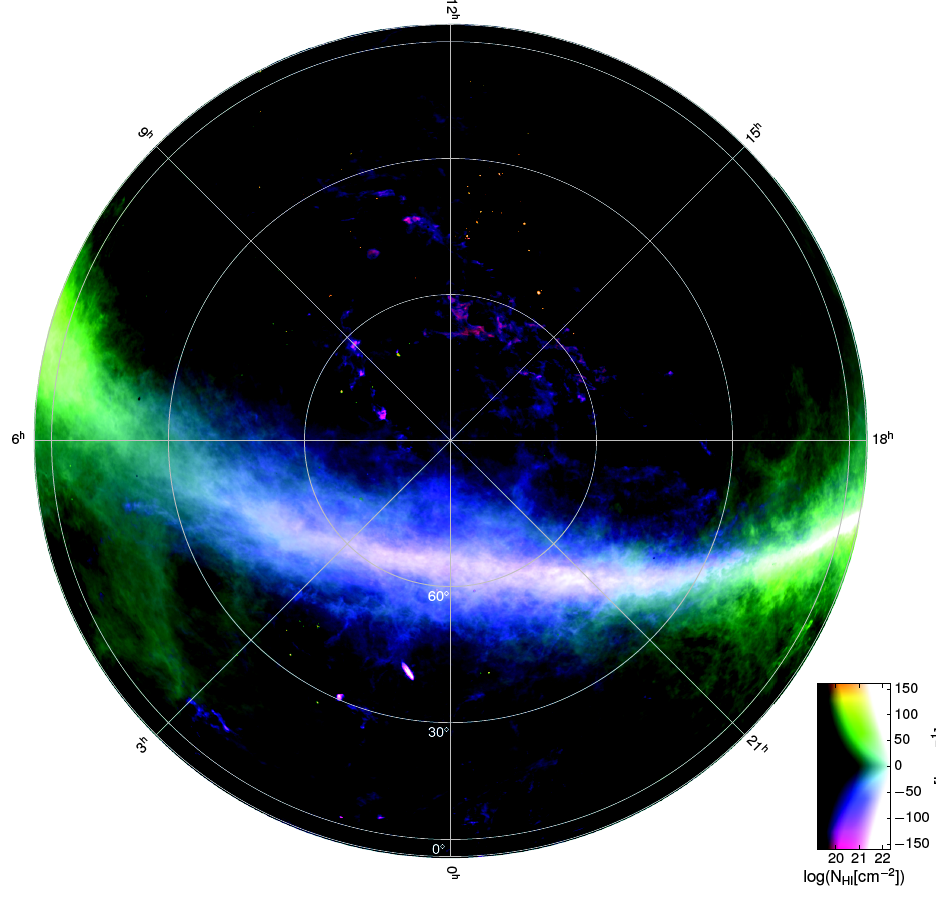The Effelsberg-Bonn HI Survey (EBHIS)
The Effelsberg-Bonn HI Survey is a scientific project headed by the Argelander-Institut für Astronomie (PI J. Kerp) in collaboration with the Max-Planck-Institut für Radioastronomie. The project is funded by the Deutsche Forschungsgemeinschaft (grants KE757/7-1 to 7-3). The first Milky Way data release is published in the first January issue 2016 of Astronomy & Astrophysics:
The arXiv version of that paper you will find hereThe Effelsberg-Bonn HI Survey: Milky Way Gas

Abstract
The Effelsberg-Bonn HI survey (EBHIS) is a joined project of the AIfA and the MPIfR to image the neutral Hydrogen (HI) content of the Milky Way galaxy and to comprise an inventury of the HI content of the extragalactic sources up to redshifts of z ~ 0.07. Observing with a bandwidth of 100 MHz both surveys are performed simultaneously. Essential for this approach is the use of state of the art >Field Programmable Gate Array (FPGA) spectrometers the 100 MHz bandwidth can be stored with high time resolution (0.5 sec) and 16.384 spectral channels. This setup is ideal for data mining, Radio-Frequency-Interference (RFI) mitigation, and testing novel RFI mitigation techniques. The observations are made with the seven beam multi-feed receiver and a first full-sky coverage is expected within a period of two years (mid 2013). The first data release will be published in Astronmy & Astrophysic in the first issue of 2016. The Milky Way data is accessible to the scientific community via CDS
and the Bonn HI serverCompared to current HI surveys like the Parkes Galactic all-sky survey (GASS) or the extragalactic HI Parkes all-sky (HIPASS) the EBHIS is even with its first coverage at a comparable sensitivty level. With the anticipated sensitivity and an advanced calibration scheme this survey will be superior to current northern HI survey, the Leiden-Argentine-Bonn survey, and will answer fundamental questions on the baryon budget, the HI mass function, and the gas phase properties that have not been addressed before. In addition the higher angular resolution allows to study the HI emission in the Milky Way in much greater detail and provides important clues on structure formation and the extraplanar gas. Apart from its own science goals the EBHIS data base provides crucial information to a broad range of science investigation, such as high energy physics (gamma & X-ray astronomy), absorption line surveys or dark matter science with FERMI.
The EBHIS raw data are calibrated and imaged via an automated pipeline and the first release of the full-sky coverage will be available in January 2016. The data products and calibration information will be directly available via an Internet interface as a service to the astronomical community.
The EBHIS survey is a well designed project that has formed a unique HI group that builds up expertise in data calibration and data management, that leads naturally to the science of the next generation radio telescopes. Furthermore, the scope of being involved in state of the art science and technical developments for next generation radio telescopes is attractive for young students to consider a career in radio astronomy. Finally, the well calibrated EBHIS survey has the potential to become the reference database of short spacing measurements for the up-coming HI surveys which are planned for the SKA pathfinder telescopes in Australia (ASKAP) and South Africa (MeerKAT) and the Westerbork Synthesis Telescope APERTIF survey.